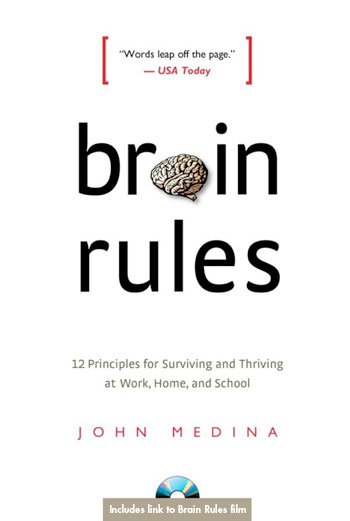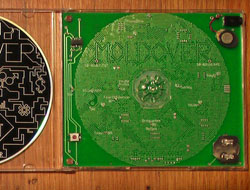Coolest CD Case EVER! Has built-in Theremin
August 31, 2009
From synthgear: “Moldover’s new CD, over 3 years in the making, not only delivers gorgeously diverse music with meaning and musical mastery, it completely redefines what it means to “play an album”. . .Moldover’s CD packaging itself IS a new musical instrument! The CD is mounted on a custom designed circuit board, intricately patterned and powering a ‘light-Theremin.’ Yes! You play the artwork and it makes sound! Only the musical supervillain genius of Moldover could develop something so stunningly innovative.”
Bad Science, Bad Dog Writing — “Paws & Effect, The Healing Power of Dogs” by Sharon Sakson
August 30, 2009
I have a problem with some dog writers.
In fact, I have a problem with a lot of dog writers.
They want so fervently to extoll the virtues and abilities of dogs that they’ll accept the most ridiculous idea so long as it’s wrapped up in a colorful and heartwarming anecdote. This does a disservice to both dogs and man. Here’s a recent example.
The following excerpt comes from Paws & Effect, The Healing Power of Dogs by Sharon Sakson. The dog in question is named Kyle, a Scottish Terrier whose owner claims that he watched TV, comprehended what he saw and even deduced the guilt of murderer Scott Petersen before any human knew he had killed his wife Laci.
“He became more and more aware of what was going on in the programs. My husband was watching The Sopranos. Kyle watched with him, but he would get really upset when people got killed. Or even if there was something harsh, like hitting another guy with a baseball bat or driving into someone with a car, He hated PBS, documentaries, or any educational like that, the kind of things I like to watch. He would give me a look like, ‘Change the channel!’”
Kyle also liked news programs, but Russie [his owner] noticed that he seemed to hate one particular person who was appearing on the screen a lot that winter. It was Scott Petersen, the husband who was eventually found guilty of killing his wife, Laci. “From the first time he ever saw him on television, he would bark and go crazy and try and bite the screen, And this was just during the time that Laci had disappeared, and they had no idea who did it. Kyle knew!”
Anyone familiar with the Clever Hans effect can tell you precisely what is going on here, since the science tells us that dogs cannot comprehend televised images due to the fact that their flicker-fusion rate differs from humans. It’s impossible for your dog to see the flashing images as you do, in a continuous stream of motion and decipher them as depicting Italian mobsters from New Jersey and duplicitous, murderous husbands.
Kyle, like Clever Hans, the amazing horse who was believed to be able to do mathematics, is taking his cue from the humans around him. It’s an engaging story and just a side light to the healing power Sakson attributes to Kyle but after reading this chapter I had to put the book down. This is a fairy tale, no matter how fervently Kyle’s owners believe it and how credulously Sakson reports it.
Ye, Paws & Effect is blurbed by respected authors like Temple Grandin, Stanley Coren, Elizabeth Marshall Thomas and Ted Kerasote. Of course, becoming a best selling author says nothing about the writers’ knowledge of basic canine science.
Once upon a time there were a class of beings known as fact-checkers who would comb through a manuscript and spot such errors and bring them to a publisher’s attention.
However, when it comes to popular dog books, it’s like Carelton Young said in the 1962 John Ford classic, The Man Who Shot Liberty Valence: “This is the West, sir. When the legend becomes fact, print the legend.”
Dogs Watching TV & Film: Or Why There is No Canine Roger Ebert
August 28, 2009
 Alexandra Horowitz, assistant professor of psychology at Barnard College has written a new book, Inside of a Dog: What Dogs, See, Smell & Know and was interviewed by BARk magazine. Here she explains why dogs could not see broadcast TV:
Alexandra Horowitz, assistant professor of psychology at Barnard College has written a new book, Inside of a Dog: What Dogs, See, Smell & Know and was interviewed by BARk magazine. Here she explains why dogs could not see broadcast TV:
“It has to do with how we process light. specialized cells in the eyes of mammals translate light waves into neural activity by changing the pigment in the cells. In the milliseconds that the pigment is changing, the cell can’t receive any more light. This leads to what is called the ‘flicker-fusion’ rate: essentially, the number of snapshots of the world that the eyes can process each second. Our flicker-fusion rate is about 60 images per second. The images on old TVs and film is really a sequence of still shots sent quickly enough to fool our eyes into seeing a continuous stream. Given our flicker-fusion rate, the films needs to be only slightly faster than 60 still images a second to trick our eyes into seeing motion. Dogs, though, have a faster flicker-fusion rate—about 70 or 80 stills per second. When watching film, they can actually detect the individual frames as well as the dark spaces between them. With the recent conversion to entirely digital television broadcasts, thought, the flicker-fusion rate is no longer relevant, since digital TV works differently. So dogs can, in theory, watch TV—though it is still not very olfactorily interesting!”
Please support Professor Horowitz’s outstanding work and buy her book. Also, if you are a dog-lover and you don’t already subscribe to BARk, what are you waiting for?
40 Free Cartoon And Comic Fonts from Hongkiat.com
August 27, 2009
The good folks at Hongkiat.com, (Online Tips for Tech Users, Designers, Bloggers) have complied an excellent resource for cartoon and comic book fonts here. They are definitely worth checking out. Thanks, Hongkiat!
How Dogs See Colors — Limited Color Vision, Not Black & White
August 21, 2009
The Puplife.com site has a very good article on canine vision, here. Humans, as you know are trichromats with three channels for processing color information. Dogs are dichromats, having only two. This means that they have limited color vision, not black and white vision as was once commonly thought.
As they say towards the bottom of the article the best ball you could get for your dog’s vision would be colored white and purple for contrast against most backgrounds, especially the green of your yard’s grass, assuming you have some left. I have a three year old Labrador who is ball crazy and her racing, sudden turns and leaps in the air to catch her favorite ball is in direct opposition to a lush green yard.
Below are two examples I’ve created using a program called Sim Daltonism. The image on the left side represents normal human color vision; the right hand image is how your dog would see the same scene. Click on the images for larger size.
Do You Know the 6 Key Factors in Getting Bitten by a Dog?
August 10, 2009
There’s an interesting site run by attorney Kenneth M. Phillips whose entire practice revolves around representing people who have been bitten by dogs.The site is packed with information and I’ve only just begun to read it in depth.
He states there’s an epidemic of dog bites in America today. I’ve read other opinions on this elsewhere yet his position does not surprise me. Consult a divorce lawyer and he’ll tell you: you need a divorce; a bankruptcy attorney will counsel you to file Chapter 11, a real estate attorney will tell you to buy land (they’re not making any more of it, he’ll say).
What I did find fascinating was his list of 6 key factors involved in dog bites. They make a great deal of sense to me. Clearly more effort must be made to educate dog owners (and the general population that comes into contact with dogs) about these six facts.
1. A dog in its own yard, and no master present. In 2008, 78% of the human fatalities were by dogs in their own yard.
2. Pit bull, Rottweiler, Akita or Chow. Most fatal dog attacks are by pit bulls. In 2008, 65% of the fatalities were by pit bulls.
3. The pack mentality. Three dogs are worse than 2, 4 are worse than 3, etc. Docile dogs often become uncharacteristically violent and vicious when they are in a pack. In 2008, 39% of the fatalities involved multiple dogs.
4. Chained or tethered. Dogs that are tied up are dangerous. In 2008, 9% of the fatalities involved chained dogs.
5. Male. Male dogs are several times more dangerous than female dogs. Un-neutered male dogs are the worst.
6. Newness. A new dog in the house is dangerous for the first 60 days, and a person who is new to a household where a dog resides is in danger of attack for the first 60 days. In 2007 and 2008, 20% of fatal dog attacks involved a new person or dog sharing a household for a period of two months or less.
— Phillips, Kenneth M. from the home page of Dog Bite Law. http://www.dogbitelaw.com/ Updated on 6/30/09, accessed on 8/10/09.
This Just In: Domestication of Dogs Location and Date in History Still Unclear
August 10, 2009
Sometimes what we learn is how much we still don’t know. Through the study of mitochondrial DNA, (genes passed along the matriarchal line) we know that domestic dogs are derived from the population of Eurasian grey wolves sometime between 15,000 and 40,000 years ago.
Here’s the logic: the most genetically diverse current dog population today should be found in the location that this gradual transformation first occurred. A 2002 study put this in East Asia. Now a more recent study shows a similar level of diversity in dogs in Africa. Africa itself cannot be where this transformation took place because they are no grey wolves that adapted to this climate.
What this means is the assumption that dogs became ‘man’s best friend’ in East Asia is brought into question. To solve this riddle definitively more DNA studies will be required in Europe, the Middle East and East Asia.
For the complete story from the National Geographic, go here.
40 New High Quality Photoshop Tutorials
August 10, 2009
Here’s an excellent collection of 40 new Photoshop tutorials from Noupe, a few screen shots of examples appear below. For the link, go here.
I’ve gotta say that I’m not a fan of the letter spacing in their logo but I’m also a dinosaur who remembers when all type was spec’ed by hand. There was print media before desk top publishing, kids.
Memory is like a “blender left running with the lid off.”
August 10, 2009
Most people believe that the brain is a lot like a recording device—that learning is something akin to pushing the “record” button (and remembering is simply pushing “playback”). Wrong. In the real world of the brain. . .nothing could be further from the truth. The moment of learning, of encoding, is so mysterious and complex that we have no metaphor to describe what happens to our brains in those first fleeting seconds.
The little we do know suggests it is like a blender left running with the lid off. The information is literally sliced into discrete pieces as it enters the brain and is splattered all over the insides of our mind. Stated formally, signals from different sensory sources are registered in separate brain areas. The information is fragmented and redistributed the instant the information is encountered. If you look at a complex picture, for example, your brain immediately extracts the diagonal lines from the vertical lines and stores them in separate areas. Same with color. If the picture is moving, the fact of its motion will be extracted and stored in a place separate than if the picture were static.
—Brain Rules, 12 Principles for Surviving and Thriving at Work, Home, and School by John Medina
Animal Rights: The Abolitionist Approach
August 2, 2009
I was in a lakeside dog park this weekend and ran into a women who is active in the local political scene dealing with the proposed culling of deer in South Western CT.
We spoke for a while about the biased coverage in the local press; hunters are the reasonable ones who want to prevent you from dying when your car strikes an errant deer or contracting Lyme disease. Animal Rights Activists are shrill, un-American crazies who want to take your guns and rights away.
She told me about Gary L. Francione‘s blog Animal Rights: The Abolitionist Approach. Francione takes a strict vegan approach to animal rights, here’s part of his mission statement:
The mission of this website is to provide a clear statement of a non-violent approach to animal rights that (1) requires the abolition of animal exploitation and rejects the regulation of animal exploitation; (2) is based only on animal sentience and no other cognitive characteristic, and (3) regards veganism as the moral baseline of the animal rights position.
Now I’ll admit up front that tonight I’m grilling cedar plank catfish and I’m well-known for my orange-ginger pork chops, so I’m not as good a person as Francione. Although I do like the line about vegetarians being people who are too insensitive to hear a carrot scream. Still, I enjoy reading points of view that differ from my own in areas of particular interest. So I plan on delving deeper into Franciones’ writings.
Along these lines I will also point you to Dominion: The Power of Man, the Suffering of Animals, and the Call to Mercy by Matthew Scully which provides powerful arguments against our current practices.








